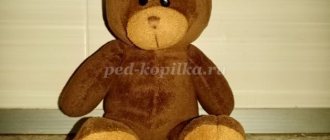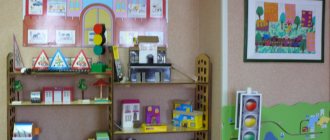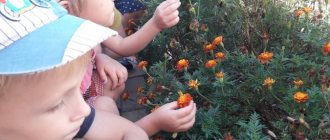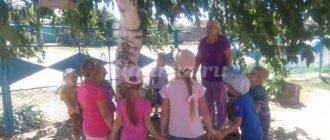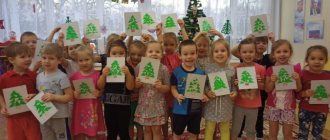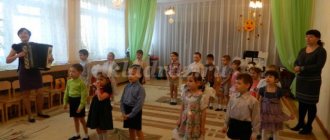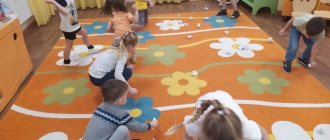Middle group. Junior preschool age. Children 4 - 5 years old
Summary of a lesson on speech development in the middle group "Excursion to the Museum of Folk Crafts" Summary of a lesson on speech development in the middle group on the topic " Excursion to the Museum of Folk Crafts"
. Goal: to form children’s knowledge about the traditions of the Russian people, to evoke an emotional response to works of oral folk art, to cultivate respect for the work of masters,...
Plan of excursions in the middle group Distribution of excursions in the middle group of the teacher at MDOU kindergarten No. 12 “Beryozka”
Goryacheva E.A.
Name of the excursion Objectives September “Autumn repaints the leaves with a long, thin brush” (ecological trail)
Learn to recognize and distinguish shrubs and trees by their characteristic…
Excursion to the spring park in May. Outline of a lesson on the world around us (middle group) on the topic
Summary of OOD in the middle group
Educational area - cognitive development
Excursion to the spring park in May.
Task:
- Introducing children to spring changes in nature in different periods: at the end of spring, the length of the day increases, the temperature rises, there are more sunny days, dandelions appear, leaves on trees and bushes, bird cherry blossoms, then lilacs, birds sing, bumblebees, butterflies appear, primroses, snowdrops.
- To develop the ability to establish connections between changes in inanimate nature and the life of plants and animals: it has become warmer - the earth has warmed up - plants are blooming - insects have appeared - birds have arrived.
- Develop the ability to compare dandelion and coltsfoot (from memory).
Integration of educational areas:
Speech development: Activate children's vocabulary: willow, maple, dandelion, anemone, nettle, lemongrass, bird cherry, lilac, ants, bumblebee, bee, chafer, nesting.
Social and communicative development: Cultivate curiosity, the desire to admire the beauty of spring nature, and treat it with care.
Preliminary work
Excursion to the spring park in April.
Progress of OOD
1 part. Preliminary conversation.
Educator: Guys, Pinocchio found out that we were going to the park today, and decided to ask us to bring the same white flower that we brought last time. Buratina really liked him. What is this flower called? (anemone). Do you think we can fulfill Buratino's request? (listen to suggestions).
— When were we in the park? What time of year? What was this period of spring called? (Mid-spring - revival).
— How can you find out whether the anemone is blooming in the park now or not? (Go and see).
- Who wants to know?
Part 2. Excursion progress:
Educator: Where have we come? To the park.
- What time of year is it? (Spring)
— How many months does spring last? Name them. (Three months: March, April, May).
Educator: Everything in nature wakes up in spring, why? (The sun is getting brighter every day, warming the earth.)
Educator: Name the signs of spring (spring sun, trees with buds, trees with young leaves, insects, birds flying from the south, animals molt, change color, breed).
Pinocchio: You are so great, you told everything so well about spring.
Educator: What has changed in the park after hibernation?
-What are the trees like? Shrubs? Why?
— Name familiar trees and shrubs? How did you know they were blooming?
—Has new grass appeared? How has she changed?
— What spring flowers have appeared? Do you find anemone among the flowers?
— What are the names of the flowers that appeared first from under the snow? (primroses, snowdrops). What other primroses do you remember (coltsfoot). Where did the snowdrops go? (bloomed).
- Which of the flowers that have appeared are similar to coltsfoot? (dandelion)
- How are they similar? How do they differ: in flowers, size, structure of the flower.
-What insects do you see?
— How did you recognize insects? What are they doing?
— Why do insects land on flowering plants? What insects have you noticed on the ground?
Watch the ants. What can you say about them? What are they doing?
Educator. Why should we protect ants?
- Why are there so many insects now?
- What migratory birds have arrived? Why?
- What are they doing now?
- What birds did you see?
- Why is the park beautiful now? (Everything blooms, especially bird cherry)
- What kind of plant is this? (lilac)
- When do you think the lilac will bloom? How did you guess?
Part 3. Pinocchio: What poems do you know about spring, about birds?
Educator: Guys, walk along the paths, look at the beauty of NATURE, listen to the birds singing.
Pinocchio: I enjoyed walking on a spring day so much that I wanted to draw a picture. Guys, can you help me?
Before leaving, you can dig up one dandelion and plant it in a flower pot.
On the topic: methodological developments, presentations and notes
Topic: “Vegetables: carrots, beets, cucumbers” Goal: formation of the concept of “vegetables” based on familiarization with the structural features and growth of carrots, beets, cucumbers. Tasks: Activation of the dictionary, development.
to promote children's interest in knowledge about vegetables through the integration of educational areas: cognition, artistic and aesthetic development.
Continue to introduce the child to plasticine and its properties; learn how to apply plasticine to a surface; develop fine motor skills of the hands, develop knowledge about vegetables; cultivate responsiveness and kindness.
Summary of a lesson on cognitive development in the junior group “Vegetables from the garden.”
Source
Excursion in the fall in the middle group “Autumn changes in nature”
Summary of the autumn excursion in kindergarten in the middle group “Autumn changes in nature”
Age category of children: 4-5 years Goals and objectives: - observation of autumn changes in nature - develop observation, logical thinking, ability to compare - promote the development of cognitive interest - educate love and respect for nature
Excursion progress:
— Guys, what time of year is it now?
(Autumn) - Listen to a poem about autumn: Autumn has come, Our garden has turned yellow.
The leaves on the birch tree are burning golden. Do not hear the cheerful Songs of the nightingale. The birds flew away to distant lands. — What signs of autumn are listed there? (the leaves turned yellow, migratory birds flew away) - What other signs of autumn do you know? (It’s cold, it rains often, leaves fall from the trees) - Correct. Look at the sky, how gloomy it has become, how few leaves are left on the trees:
— Now we will take a walk around the area around the kindergarten and observe how nature has changed with the onset of autumn. - Here is our flowerbed. Do you remember how beautiful the flowers were here in the summer? There were a lot of flowers, we watered them and loosened them. Look what happened to them now? (They dried up, turned black, withered).

- Why do you think this happened? (They feel bad, it’s cold, there’s not enough sun) - Look, this is Rudbeckia, it froze when the snow fell:
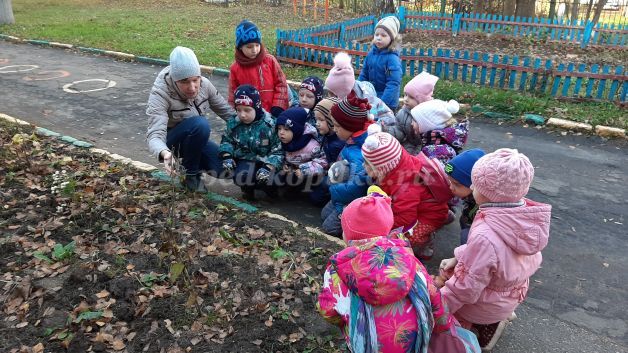
- Now let's see what has changed in the garden? (The harvest was harvested, almost nothing remained in the beds, only weeds and fallen leaves). - Look, what kind of vegetable did I find in the garden? (carrot)
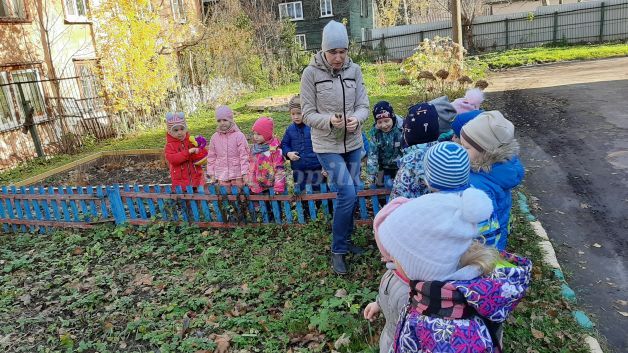
— Guys, look, how have the trees and shrubs changed? (The leaves have turned yellow, the leaves are falling, some are already without leaves)
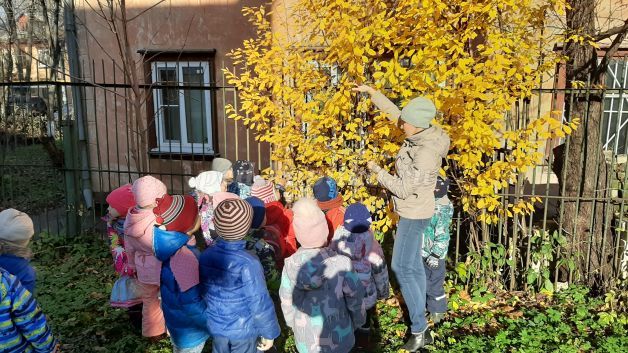
“Are we really not going to see a single flower again?” There are flowers that are not as afraid of the cold as others. Look, there are still flowers left on Hydrangea:
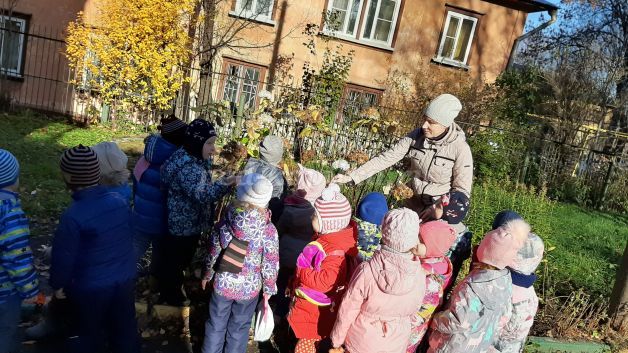
- Now look here. What kind of tree is this? (Rowan) That's right, come closer, we'll take a look at it. What do we see on the branches of rowan? (Berries). - Who will be happy with these berries? (Birds) - That's right, the birds that stay with us for the winter.
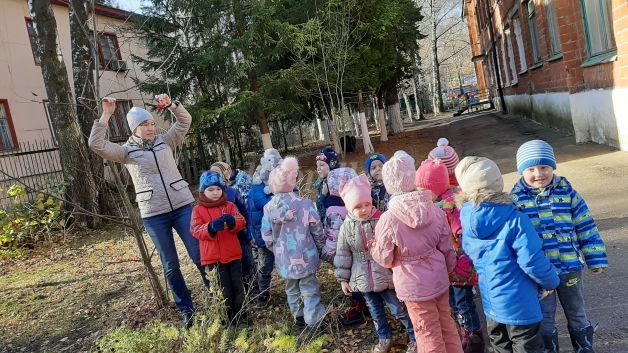
“Can’t we find a single green tree with you?” (Let's find that the Christmas trees remain green) - That's right, almost all coniferous plants remain green. Let's take a closer look at the spruce. What are the needles on spruce trees called? (Needles) What can you say about spruce needles? (green, prickly, does not fall off in the winter)
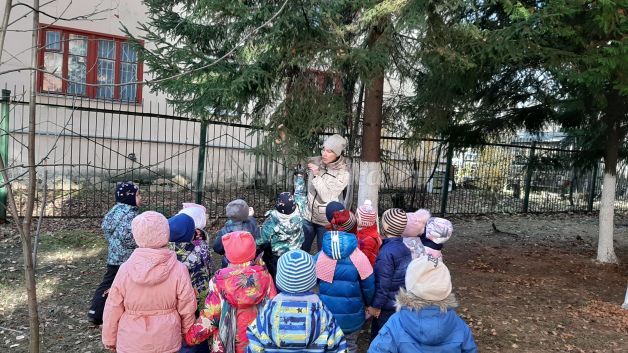
Did you guys like our tour? (Yes) We will walk here again when the next season comes to observe how nature changes. What time of year will be after autumn? (Winter)
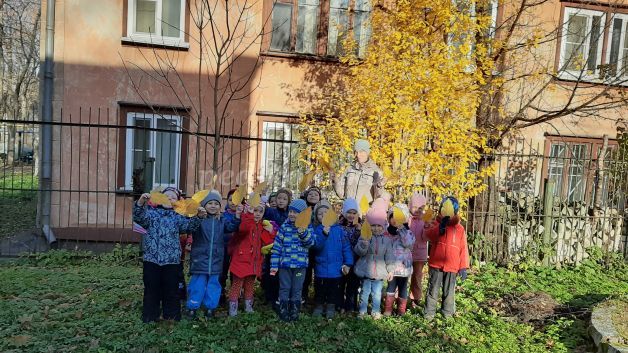
We recommend watching:
Summary of educational activities in the middle group with the use of ICT on the topic “Autumn” Summary of a speech therapy lesson in the middle group on the topic “Autumn” Autumn city tour for children Direct educational activities in the middle group of kindergarten on the topic: Autumn
Similar articles:
Synopsis of a sightseeing educational-ecological excursion in the middle group “Autumn Journey along the Ecological Trail”
MAGAZINE Preschooler.RF
Integration of areas: “Cognition”, “Communication”, “Safety”, “Reading fiction”, “Health”. Materials and equipment: magnetic board, subject pictures depicting people working in kindergarten, poem ball. Program content: Clarify and activate the vocabulary on the topic: “Kindergarten”. "Communication". Develop children's connected speech." "Communication". To consolidate ideas about the need and importance of adult labor.” "Cognition". Introduce dangerous situations in kindergarten. "Safety". Continue introducing children to riddles and poems. "Reading fiction." Contents of GCD: Organizational moment. The teacher tells the children that today we have an unusual activity. We will go on a tour of the kindergarten and listen to the stories of the adults who work here. I ask you to be careful and remember all the stories. I also want to remind you how to behave during the excursion. Don't make any noise, because classes have started in all groups. Do not run or push when going up or down stairs. Do not touch anything without permission in the premises where you and I will enter. Don’t forget to say hello, thank you for your story, and say goodbye. Conversation on the topic “Kindergarten. Professions in kindergarten." The teacher guides the children around the kindergarten. They visit the manager's office, the medical office, the laundry room, the pantry, and the kitchen. The head of a kindergarten, a doctor, a nurse, a laundress, a storekeeper, and a cook speak to the children about their professions. They introduce children to the premises of the kindergarten, show equipment, devices, tools. Educator. Our tour of the kindergarten has ended. Remember where we visited, what we saw, what we learned new. Each of you must talk about one part of our excursion. The teacher places pictures on a magnetic board with images of the people the children are talking about. 1st child. We visited the manager's office. There we saw……… The manager supervises the work of the kindergarten. She has a lot of important things to do. (The teacher helps the children tell the story) Teacher. Very good. Now let's talk about visiting a medical office. 2nd child. We visited the medical office. A doctor and a nurse work there. (Additions from the teacher - The doctor and nurse showed us scales, a stadiometer, a cabinet and refrigerator with medicines, thermometers, syringes. All this is needed to monitor our health). Ball game. "Who's doing what?" - I will throw a ball to one of you and name your profession. You will catch the ball and list what the person is doing. Guessing riddles. The teacher invites the children to guess riddles. Smelly cutlets, salads, vinaigrettes? Children. -This is the cook. He cooks delicious dishes for us. Educator. - We teach children to count, draw, love nature, respect all work. Children. - These are educators. They teach us to count, draw, love nature, and work. Educator. You solved the riddles and gave explanations of how you did it. Well done! Finger gymnastics “Our group”. Everyone in our group is friends. They rhythmically knock their fists against each other. The youngest is me. They unclench their fingers, starting with the little finger. This is Masha, this is Sasha, this is Yura, this is Dasha. Game "Who does what?" Children make sentences based on a picture of kindergarten workers. — The cook is making soup. — The teacher’s assistant is setting the table. (Etc.) Educator. — You made beautiful sentences. Well done, Conversation – discussion “What dangers can be encountered in kindergarten?” Summarizing. The teacher invites the children to tell what they were interested in doing during the lesson and evaluates the children’s work.| Next > |
On the topic: methodological developments, presentations and notes
NOTE FOR A NODDLE FOR MIDDLE PRESCHOOL AGE TOPIC: “WHAT DO I KNOW ABOUT MYSELF AND ABOUT MY HEALTH” (Educational area Cognition. Communication. Integration: Health, Fiction.
Ethnocultural education in kindergarten involves the study of folklore. This lesson is based on a fairy tale that is well known to children. Areas like Co.
Program content - Learn to guess riddles about wild animals; - Clarify the idea of how wild animals winter, practice in the formation of the names of young wild animals; - Exercise in the form.
A holiday with a storyline and environmental content. Preliminary work is required. It consisted of conducting experiments, observing the growth and development of plants from various grains and seeds, etc.
Gift for mom..(applique).
Source
